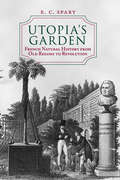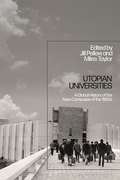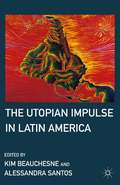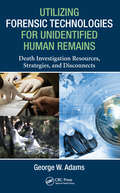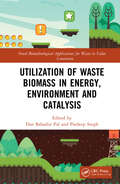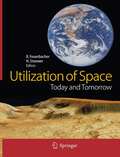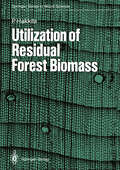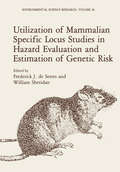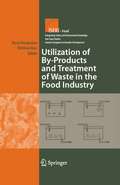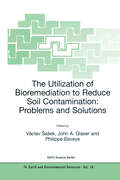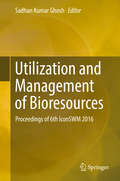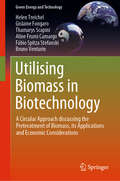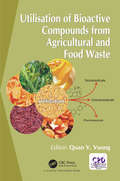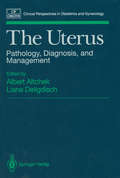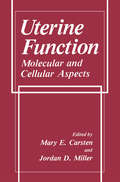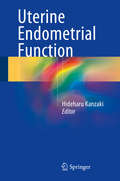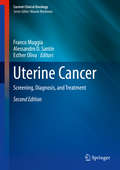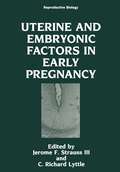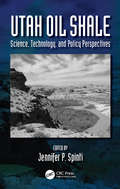- Table View
- List View
Utopia's Garden: French Natural History from Old Regime to Revolution
by E. C. SparyThe royal Parisian botanical garden, the Jardin du Roi, was a jewel in the crown of the French Old Regime, praised by both rulers and scientific practitioners. Yet unlike many such institutions, the Jardin not only survived the French Revolution but by 1800 had become the world's leading public establishment of natural history: the Muséum d'Histoire Naturelle. E. C. Spary traces the scientific, administrative, and political strategies that enabled the foundation of the Muséum, arguing that agriculture and animal breeding rank alongside classification and collections in explaining why natural history was important for French rulers. But the Muséum's success was also a consequence of its employees' Revolutionary rhetoric: by displaying the natural order, they suggested, the institution could assist in fashioning a self-educating, self-policing Republican people. Natural history was presented as an indispensable source of national prosperity and individual virtue. Spary's fascinating account opens a new chapter in the history of France, science, and the Enlightenment.
Utopia's Garden: French Natural History from Old Regime to Revolution
by E. C. SparyThe royal Parisian botanical garden, the Jardin du Roi, was a jewel in the crown of the French Old Regime, praised by both rulers and scientific practitioners. Yet unlike many such institutions, the Jardin not only survived the French Revolution but by 1800 had become the world's leading public establishment of natural history: the Muséum d'Histoire Naturelle. E. C. Spary traces the scientific, administrative, and political strategies that enabled the foundation of the Muséum, arguing that agriculture and animal breeding rank alongside classification and collections in explaining why natural history was important for French rulers. But the Muséum's success was also a consequence of its employees' Revolutionary rhetoric: by displaying the natural order, they suggested, the institution could assist in fashioning a self-educating, self-policing Republican people. Natural history was presented as an indispensable source of national prosperity and individual virtue. Spary's fascinating account opens a new chapter in the history of France, science, and the Enlightenment.
Utopian Universities: A Global History of the New Campuses of the 1960s
by Jill Pellew and Miles TaylorIn a remarkable decade of public investment in higher education, some 200 new university campuses were established worldwide between 1961 and 1970. This volume offers a comparative and connective global history of these institutions, illustrating how their establishment, intellectual output and pedagogical experimentation sheds light on the social and cultural typography of the long 1960s. With an impressive geographic coverage - using case studies from Europe, the Americas, Africa and Asia - the book explores how these universities have influenced academic disciplines and pioneered new types of teaching, architectural design and student experience. From educational reform in West Germany to the establishment of new institutions with progressivist, interdisciplinary curricula in the Commonwealth, the illuminating case studies of this volume demonstrate how these universities shared in a common cause: the embodiment of 'utopian' ideals of living, learning and governance. At a time when the role of higher education is fiercely debated, Utopian Universities is a timely and considered intervention that offers a wide-ranging, historical dimension to contemporary predicaments.
Utopian Universities: A Global History of the New Campuses of the 1960s
In a remarkable decade of public investment in higher education, some 200 new university campuses were established worldwide between 1961 and 1970. This volume offers a comparative and connective global history of these institutions, illustrating how their establishment, intellectual output and pedagogical experimentation sheds light on the social and cultural typography of the long 1960s. With an impressive geographic coverage - using case studies from Europe, the Americas, Africa and Asia - the book explores how these universities have influenced academic disciplines and pioneered new types of teaching, architectural design and student experience. From educational reform in West Germany to the establishment of new institutions with progressivist, interdisciplinary curricula in the Commonwealth, the illuminating case studies of this volume demonstrate how these universities shared in a common cause: the embodiment of 'utopian' ideals of living, learning and governance. At a time when the role of higher education is fiercely debated, Utopian Universities is a timely and considered intervention that offers a wide-ranging, historical dimension to contemporary predicaments.
The Utopian Impulse in Latin America
by Kim Beauchesne and Alessandra SantosAn exploration of the concept of utopia in Latin America from the earliest accounts of the New World to current cultural production, the carefully selected essays in this volume represent the latest research on the topic by some of the most important Latin Americanists working in North American academia today.
Utilizing Forensic Technologies for Unidentified Human Remains: Death Investigation Resources, Strategies, and Disconnects
by George W. AdamsIn missing and unidentified investigations, an abyss of dissonance seems to exist between law enforcement and the community they serve that all too often creates grating wounds that may never heal. Utilizing Forensic Technologies for Unidentified Human Remains: Death Investigation Resources, Strategies, and Disconnects bridges this abyss.This is th
Utilization of Waste Biomass in Energy, Environment and Catalysis (Novel Biotechnological Applications for Waste to Value Conversion)
by Dan Bahadur PalBiomass finds its application as feedstock to produce biofuels and other value-added products, which finds usage in energy and environmental areas with particular focus on bioenergy production from different biomass and high-volume, medium-value industrial products. This book investigates problems of controlled synthesis of these materials and the effect of their morphological, physical, and chemical characteristics on their adsorption or desorption capacity and recent progress in green catalysts derived from biomass for various catalytic applications. Socioeconomic impacts on environment and climate regarding waste biomass are discussed as well. Features Covers recent progress on green catalysts derived from biomass Explores the biomass conversion to different resources Introduces the utilization of biowaste in environmental aspects Discusses the biomass applications in different types of energy Proposes microbial waste biomass as a resource of renewable energy This book is aimed at professionals and senior undergraduate students in environmental sciences, energy studies, and environmental and chemical engineering.
Utilization of Waste Biomass in Energy, Environment and Catalysis (Novel Biotechnological Applications for Waste to Value Conversion)
by Dan Bahadur Pal Pardeep SinghBiomass finds its application as feedstock to produce biofuels and other value-added products, which finds usage in energy and environmental areas with particular focus on bioenergy production from different biomass and high-volume, medium-value industrial products. This book investigates problems of controlled synthesis of these materials and the effect of their morphological, physical, and chemical characteristics on their adsorption or desorption capacity and recent progress in green catalysts derived from biomass for various catalytic applications. Socioeconomic impacts on environment and climate regarding waste biomass are discussed as well. Features Covers recent progress on green catalysts derived from biomass Explores the biomass conversion to different resources Introduces the utilization of biowaste in environmental aspects Discusses the biomass applications in different types of energy Proposes microbial waste biomass as a resource of renewable energy This book is aimed at professionals and senior undergraduate students in environmental sciences, energy studies, and environmental and chemical engineering.
Utilization of Space: Today and Tomorrow
by Berndt Feuerbacher Heinz StoewerDescribes the various fields of application of astronautics and the underlying technology. Written on a level understandable for non-specialists. Provides an outlook on the future of this fascinating field.
Utilization of Residual Forest Biomass (Springer Series in Wood Science)
by Pentti HakkilaAn increase in the demand for wood results in improved recovery and less residual biomass in the forests. Paradoxically, interest in forest residue as a renewable source of raw material seems to be in a reverse ratio to its availability in a certain area. Finland and Sweden are probably more dependent on forestry and forest in dustries than any other developed countries in the world. A sufficiency of raw ma terial for integrated forest industries is vital for the national economy of both countries, and a great deal of attention is being paid to the long-term potential of unutilized biomass left behind in logging operations. Furthermore, since these countries possess no reserves of fossil fuels, and since their per-capita consump tion of primary energy is exceptionally high, they also consider unmerchantable forest biomass a realistic source of indigenous energy. A joint Nordic research project on harvesting and utilization of logging residue was carried out in 1969-1976 under the auspices of the Nordic Research Council on Forest Operations. This fruitful cooperation soon gave rise to related national projects in Sweden, Finland, Norway, and Denmark, stimulating further research and producing practical applications. Concurrently, particularly after the worldwide energy crisis in 1973, research on all aspects of utilization of forest bio mass mushroomed in the United States, Canada, and the Soviet Union. An ex plosive increase occurred in both the number and diversity of biomass studies.
Utilization of Mammalian Specific Locus Studies in Hazard Evaluation and Estimation of Genetic Risk (Environmental Science Research #28)
by F.J. De SerresThe magnitude of the threat to the human genetic material posed by environmental agents has not as yet been fully determined. Never theless, the potential hazards of many chemicals have been identi fied by studies on lower organisms. However, too little is known regarding the comparability or lack of it between the metabolic pathways available in such organisms and those in man. Although at present there is great public concern for what is considered by some as the excessive use of laboratory animals in toxicological testing, it seems clear that the usage of mammalian systems may be deemed necessary. It has been proposed that cell culture systems might suffice to meet this need, however, such approaches cannot match the complexity of physiological occurances that are present in the intact animal. For studies of genetic effects, some non-invasive human test systems are presently available. These do not, however, meet the re quirements for extensive laboratory studies. In order to assess the risks to humans of environmental factors such laboratory investiga tions are essential. Therefore, for the forseeable future reliance on experiments using laboratory animals will be necessary. This Volume, which contains the proceedings of a workshop which was held at the National Institute of Environmental Health Sciences, March 29-31, 1982, explores the existing methodologies and their utility for risk estimations. It covers the most well developed human systems, as well as the most widely used animal tests.
Utilization of By-Products and Treatment of Waste in the Food Industry (Integrating Food Science and Engineering Knowledge Into the Food Chain #3)
by Vasso Oreopoulou Winfried RussThis is the third volume of the ISEKI-Food book series. It deals with the main features of utilization of the food industry waste, defined thereby as by-product, and the treatments necessary to discard waste to environmental acceptors. It discusses the utilization of byproducts of plants and fish, and presents case studies on waste treatment in the food industry.
The Utilization of Bioremediation to Reduce Soil Contamination: Problems and Solutions (NATO Science Series: IV: #19)
by Václav Šašek John A. Glaser Philippe BaveyeTraditional reliance on chemical analysis to understand the direction and extent of treatment in a bioremediation process has been found to be inadequate. Whereas the goal of bioremediation is toxicity reduction, few direct, reliable measures of this process are as yet available. Another area of intense discussion is the assessment of market forces contributing to the acceptability of bioremediation. Finally, another important component is a series of lectures and lively exchanges devoted to practical applications of different bioremediation technologies. The range of subjects covers a wide spectrum, encompassing emerging technologies as well as actual, full-scale operations. Examples discussed include landfarming, biopiling, composting, phytoremediation and mycoremediation. Each technology is explored for its utility and capability to provide desired treatment goals. Advantages and limitations of each technology are discussed. The concept of natural attenuation is also critically evaluated since in some cases where time to remediation is not a significant factor, it may be an alternative to active bioremediation operations.
Utilization and Management of Bioresources: Proceedings of 6th IconSWM 2016
by Sadhan Kumar GhoshThe book contains high-quality research papers presented at Sixth International Conference on Solid Waste Management held at Jadavpur University, Kolkata India during November 23-26, 2016. The Conference, IconSWM 2016, is organized by Centre for Quality Management System, Jadavpur University in association with premier institutes and societies of India. The researchers from more than 30 countries presented their work in Solid Waste Management. The book is divided into two volumes and deliberates on various issues related to innovation and implementation in sustainable waste management, segregation, collection, transportation of waste, treatment technology, policy and strategies, energy recovery, life cycle analysis, climate change, research and business opportunities.
Utilising Biomass in Biotechnology: A Circular Approach discussing the Pretreatment of Biomass, its Applications and Economic Considerations (Green Energy and Technology)
by Aline Frumi Camargo Fábio Spitza Stefanski Helen Treichel Gislaine Fongaro Thamarys Scapini Bruno VenturinThis book addresses the developing area of biomass for technological applications. Written by leading researchers in the field, the book differs from other literature available by providing a detailed, in-depth discussion of the characteristics of these materials. The use of biomass for technological applications is a rapidly growing area in materials engineering and green bioprocesses. In this approach, pre-treatments focus on the bioavailability of nutrients and facilitate the use of biomass for delivering byproducts (e.g. enzymes) and for bioenergy production, both of which are discussed at length in this book. In this regard, it explores various aspects of the structural complexity of residual biomass produced by agricultural, industrial and livestock activities for biotechnological purposes, and assesses both conventional and emerging pre-treatments (e.g. biological, enzymatic and physical–chemical). This book reveals the advantages of these techniques, both individually and in combination, making it an excellent resource for all readers interested in cutting-edge applications of biomass.
Utilisation of Bioactive Compounds from Agricultural and Food Production Waste
by Quan V. VuongThe large quantity of waste generated from agricultural and food production remains a great challenge and an opportunity for the food industry. As there are numerous risks associated with waste for humans, animals and the environment, billions of dollars are spent on the treatment of agricultural and food waste. Therefore, the utilisation of bioactive compounds isolated from waste not only could reduce the risks and the costs for treatment of waste, but also could potentially add more value for agricultural and food production. This book provides comprehensive information related to extraction and isolation of bioactive compounds from agricultural and food production waste for utilisation in the food, cosmetic and pharmaceutical industries. The topics range from an overview on challenges and opportunities related to agricultural and food waste, the bioactive compounds in the waste, the techniques used to analyse, extract and isolate these compounds to several specific examples for potential utilisation of waste from agricultural and food industry. This book also further discusses the potential of bioactives isolated from agricultural and food waste being re-utilised in the food, cosmetic and pharmaceutical industries. It is intended for students, academics, researchers and professionals who are interested in or associated with agricultural and food waste.
Utilisation of Bioactive Compounds from Agricultural and Food Production Waste
by Quan V. VuongThe large quantity of waste generated from agricultural and food production remains a great challenge and an opportunity for the food industry. As there are numerous risks associated with waste for humans, animals and the environment, billions of dollars are spent on the treatment of agricultural and food waste. Therefore, the utilisation of bioactive compounds isolated from waste not only could reduce the risks and the costs for treatment of waste, but also could potentially add more value for agricultural and food production. This book provides comprehensive information related to extraction and isolation of bioactive compounds from agricultural and food production waste for utilisation in the food, cosmetic and pharmaceutical industries. The topics range from an overview on challenges and opportunities related to agricultural and food waste, the bioactive compounds in the waste, the techniques used to analyse, extract and isolate these compounds to several specific examples for potential utilisation of waste from agricultural and food industry. This book also further discusses the potential of bioactives isolated from agricultural and food waste being re-utilised in the food, cosmetic and pharmaceutical industries. It is intended for students, academics, researchers and professionals who are interested in or associated with agricultural and food waste.
The Uterus: Pathology, Diagnosis, and Management (Clinical Perspectives in Obstetrics and Gynecology)
by Albert Altchek, Liane DeligdischUterine Function: Molecular and Cellular Aspects
by M. E. Carsten J. D. MillerThe frontispiece, Leonardo da Vinci's drawing of the embryo in the womb, was chosen as a starting point for this book. It was Leonardo who in his notebooks and drawings combined artistic composition and accurate recording of the anatomy of the human body. Leonardo studied human anatomy in order to execute artistic drawings. His aim was to clarify form and function of human organs including reproductive organs. He followed up his extensive research with graphic representa tion and thereby initiated record keeping as a basis of scientific investigation. His records, accurate three-dimensional drawings, allowed others to reproduce his find ings and to test for correctness. Results could be updated and refined. Only after these steps can abnormalities be ascertained and defined as pathology. Though Leonardo was both artist and scientist, it is assumed that his anatomic drawings were used to improve his art, and thus scientific endeavor was at the service of his art. Anatomy, the offspring of science and art, is an integration of the two and became an accepted branch of the natural sciences. Although art and science continued to interact throughout the Renaissance, art was often placed in the service of science. In the course of history that followed, art and science in creasingly followed separate ways.
Uterine Endometrial Function
by Hideharu KanzakiThis book focuses on uterine endometrial function and receptivity from multiple perspectives. The chapters cover a variety of topics including the role of estrogen and progesterone, animal models, parameters for assessing endometrial receptivity, the mechanism of angiogenesis, epigenetic regulation, and stem/progenitor cells. Despite nearly 35 years of experience with in vitro fertilization, the rate of successful implantations remains low. Abnormal endometrial receptivity has been proposed as one of the factors contributing to reduced reproductive potential in women, but our understanding of it is limited. Endometrial receptivity results from an orchestrated interplay between the embryo and the maternal endometrium, and the receptive status, known as the window of implantation, is reached only briefly in the mid-luteal phase. This book provides a comprehensive overview of the latest advances in endometrial function and paves the way for innovative treatments and drug development for infertility. This work will appeal to a wide readership, from researchers on endometrial function and assisted reproductive technology (ART) to clinicians and technicians in the field of gynecology.
Uterine Cancer: Screening, Diagnosis, And Treatment (Current Clinical Oncology Ser.)
by Franco Muggia Alessandro D. Santin Esther OlivaThere are more than 63,000 new cases of uterine and endometrial cancer each year in the United States, up from approximately 41,000 when the first edition of Uterine Cancer was published in 2009. A book focusing on these cancers was timely, with emergent sophistication in diagnosis increasingly impacting clinical decision-making. However, five years later, the need for an updated book on this topic is even stronger as oncologists recognize opportunities to impact the outcome on women that are increasingly diagnosed with these malignancies. Uterine Cancer: Screening, Diagnosis, and Treatment, Second Edition, part of the Current Clinical Oncology series, enhances the awareness on this somewhat neglected area of therapeutics, helping to integrate targeted therapies into the management of women with uterine cancer. Written by experts in the field in a highly practical and comprehensive manner, it is a must-have for all gynecological residents and fellows, as well as gynecological oncologists, medical oncologists, radiation oncologists, and family practice doctors who wish to provide their patients with the best possible care.
Uterine and Embryonic Factors in Early Pregnancy (Reproductive Biology)
by C. RichardLyttle Jerome F. StraussHuman reproduction is the most dynamic of processes. The events which lead to the birth of a normal healthy infant have their origin long before actual fertilization. Indeed, the whole process can be looked upon as a continuum. Human fertilization and early development, once sequestered in the protective environment of the fallopian tubes and uterus, have now been exposed in the laboratory. These events have, over time, been extensively observed and catalogued in animal models. The tools of modem morphology and molecular biology have reopened issues long since considered settled as facets of early reproduction are reexplored. This volume, consisting of the proceedings of a workshop on uterine and embryonic factors in early pregnancy, has been designed to enhance that effort. Attention is focused largely on early embryonal development with special attention to the interrelationship between the embryo and the uterus in early pregnancy. Each of the contributing scientists brings with him or her the perspective of one specific discipline or another. The common denominator is the application of emerging techniques in modem molecular biology to problems pertaining to embryonal-uterine interaction. The goal is to consider specific areas of concern in a multidisciplinary way and to reexplore the factors behind early development and implantation. Uterine complement, the function of uterine macrophages immunoregulatory loops in the peri-implantation period, colony stimulating factors and interferon-like factors are reviewed and their interrelationship explored. Uterine angiogenesis factors as well as embryonic growth factors are also considered.
Utah Oil Shale: Science, Technology, and Policy Perspectives
by Jennifer SpintiIncludes full-color isopach and richness maps for each organic-rich and organic-lean oil shale interval within the upper Green River Formation. Offers computational exploration of trade-offs in drilling and heating options on the net energy return for oil produced from an in situ process. Analyzes costs and emissions associated with in situ production of oil shale. Discusses legal and policy issues for a nascent oil shale industry.
Utah Oil Shale: Science, Technology, and Policy Perspectives
by Jennifer P. SpintiIncludes full-color isopach and richness maps for each organic-rich and organic-lean oil shale interval within the upper Green River Formation. Offers computational exploration of trade-offs in drilling and heating options on the net energy return for oil produced from an in situ process. Analyzes costs and emissions associated with in situ production of oil shale. Discusses legal and policy issues for a nascent oil shale industry.
Using UEB for Science (PDF)
by RnibThis book is a guide to representing science in Unified English Braille and is intended for use by all those who are involved with the teaching of science to students who use braille as their main medium for communication. The previous edition was published in 2008 and was based on Braille Science Notation BAUK/RNIB 2008. This document contains examples of most of the common units of measurement and chemical symbols found in the Key Stage 3, Key stage 4, and Advanced level curricula. The examples are not meant to be exhaustive but should act as a guide to solving the common problems which occur when transcribing science notation into Unified English Braille. Major topics covered in this book are numbers and maths, unit abbreviations, chemistry, physics (including circuit diagrams) and genetics. This book is a guide to representing science in Unified English Braille. If you would like a hard copy print or braille edition, these can be purchased through RNIB's Online Shop: rnib.org.uk/shop (Print TC21448, Braille TC21449).
